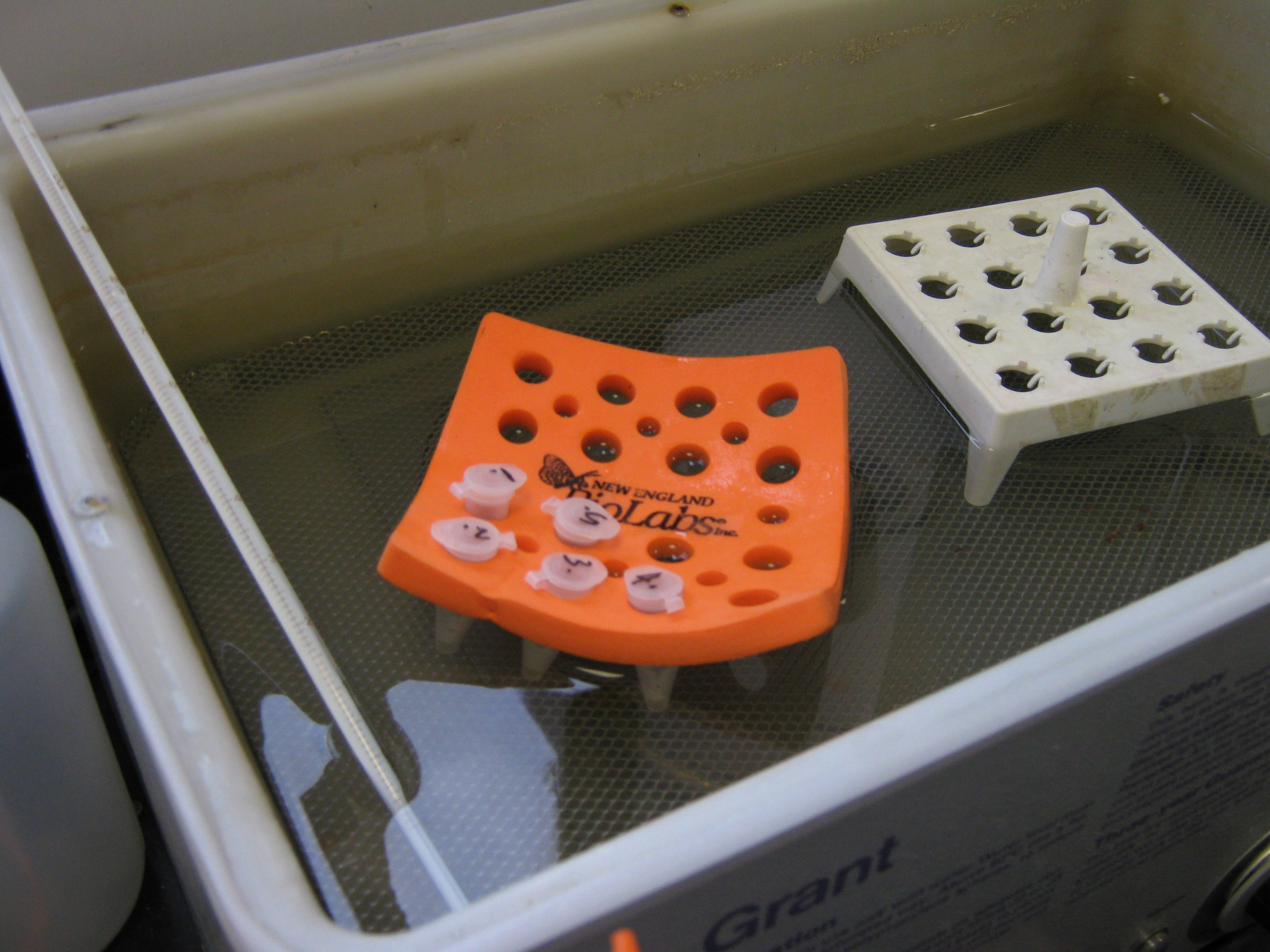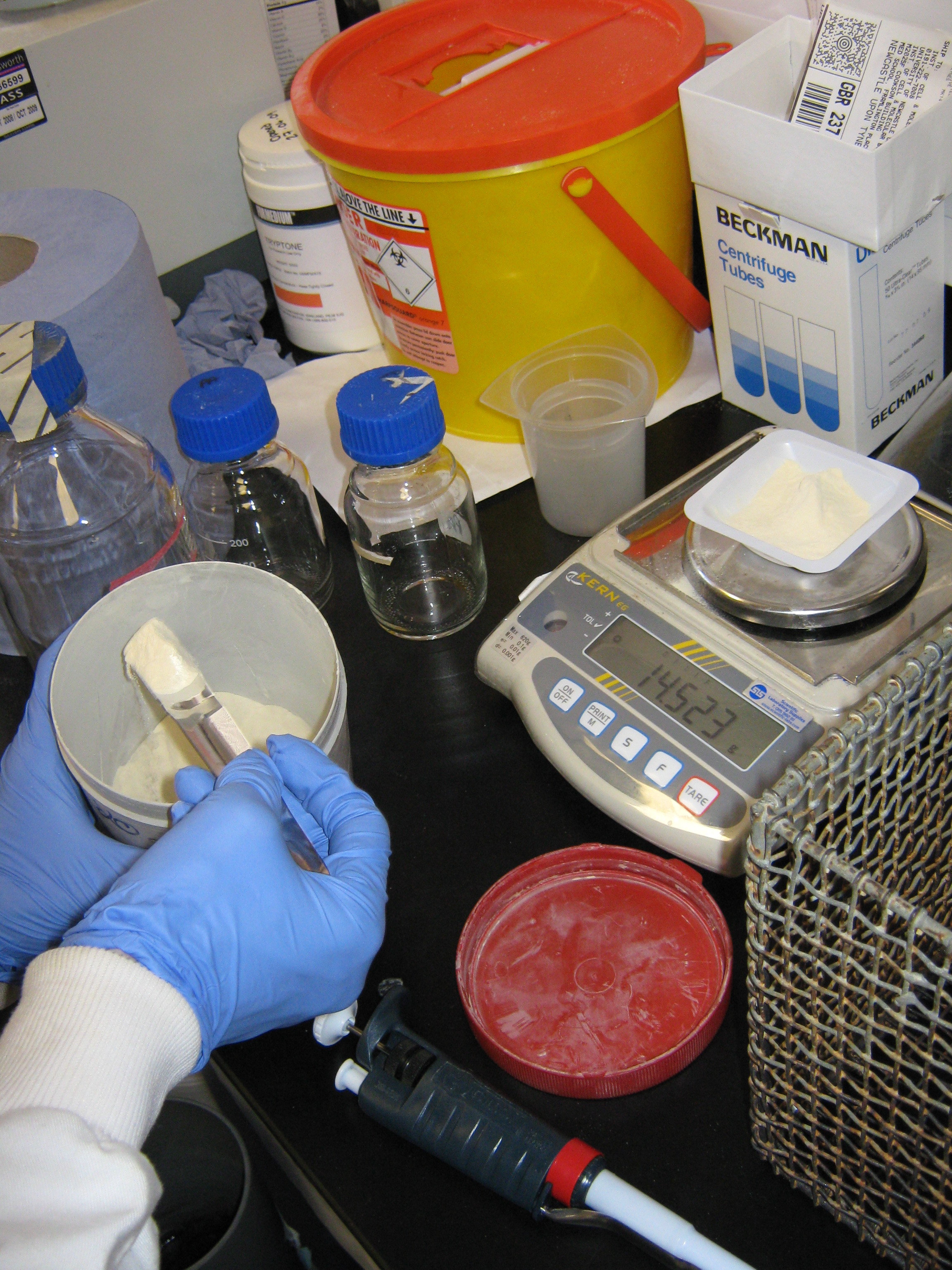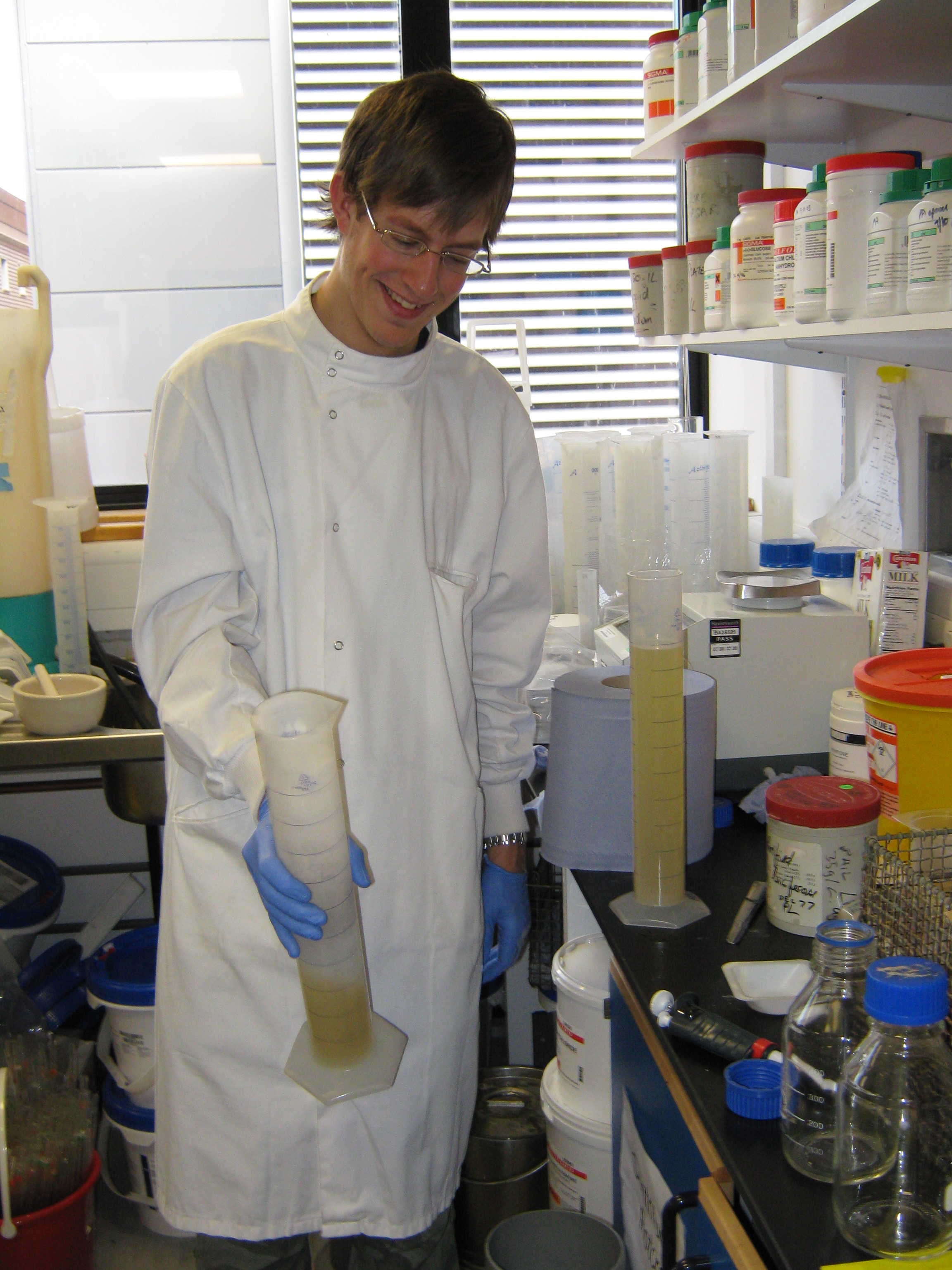Team:Newcastle/Labwork/24 July 2009
From 2009.igem.org
Babyneurone (Talk | contribs) (→Transforming JM109 E.coli cells) |
|||
| (36 intermediate revisions not shown) | |||
| Line 3: | Line 3: | ||
{{:Team:Newcastle/Left}} | {{:Team:Newcastle/Left}} | ||
__NOTOC__ | __NOTOC__ | ||
| - | =Lab | + | [[Image:Team Newcastle 2009 iGEM ProbationaryP-Sign.PNG|50px|right]] |
| + | =Formal Lab Session - 24th July 2009= | ||
| + | [[Image:Team Newcastle 2009 iGEM 24-07-09 IMG 0133.JPG|350px|center]] | ||
| + | |||
| + | |||
==Introduction== | ==Introduction== | ||
| - | + | ||
| + | [[Image:Team Newcastle 2009 iGEM 24-07-09 IMG 0132.JPG|200px|thumb|Preparing some LB solution ]] | ||
| + | The previous lab session has seen the team make a start on the real lab work and also beginning to finish the work involved with the introductory lab sessions. | ||
| + | |||
| + | To begin the real lab work five BioBricks from the Spring Distribution were hydrated and stored in the freezer, namely BioBricks ''BBA_C0056'' (cI in the lambda phage), ''BBa_B1002'' (terminator sequence), ''BBa_C0077'' (CinR activator), ''BBa_C0076'' (autoinducer synthetase) and ''BBa_R0077'' (promoter which is CinR and HSL regulated - RBS+) | ||
| + | |||
| + | The real lab work also involved the team inoculating 2 flasks of 100ml LB with ''E. coli'' containing ''pMUTIN4'' and growing the cultures overnight in the 37ºC orbital incubator. | ||
| + | |||
| + | The introductory lab session work saw the team conduct the first few stages of the ethanol precipitation of the ''GFP'' and ''RFP'' midi-prep samples. | ||
| + | |||
| + | For work done for the introductory lab sessions, [https://2009.igem.org/Team:Newcastle/IntroductoryLabwork/24_July_2009 please click on this link]. Meanwhile, as far as real lab work goes, the team needs to transform ''E. coli'' cells with the five BioBricks which were prepared yesterday from the Spring Distributions. The team also need to store away the cultures of ''E. coli'' cells which contain the ''pMUTIN4'' plasmid. | ||
==Practical Outline== | ==Practical Outline== | ||
| - | + | By the end of the day the iGEM team need to: | |
| + | # Tranform some ''E. coli'' cells (probably Promega ''JM109'' ''E. coli'' cells) with the five BioBricks recently prepared from the Spring Distributions. | ||
| + | # Prepare the ''E. coli'' cells, which contain the plasmid ''pMUTIN4'', for long term storage. | ||
| + | <br> | ||
| + | |||
| + | ==Procedure== | ||
| + | ===Transforming ''JM109'' ''E.coli'' cells=== | ||
| + | |||
| + | In carrying out the transformation process, the team decided to use commercial ''JM109'' ''E. coli'' cells purchased from Promega. Along with the cells, [http://www.promega.com/tbs/tb095/tb095.html Promega enclosed their own protocol] which we followed. There were a few changes that were made however: | ||
| + | <br> | ||
| + | * Step 3 - instead of adding 100ul of Competent Cells to the culture tubes, only 50ul was transferred. | ||
| + | * Step 4 - the DNA added to the competent cells was 5ul instead of 10ul. | ||
| + | * Step 8 - the media used to grow the transformant cells was LB and not SOC. | ||
| + | <br> | ||
| + | We also took an alternative step when it came to step 8. The 'Notes' section of the Promega protocol gave us an option of rather spreading the transformant ''E. coli'' cells on plates (with antibiotics present), the cells are pelleted and resuspended in fresh 200ul of LB solution. | ||
| - | == | + | ===Plating out the transformant colonies=== |
| - | + | [[Image:Team Newcastle 2009 iGEM 24-07-09 IMG 0138.JPG|200px|thumb|Mathew preparing some LB solution]] | |
| + | Five agar plates containing LB + ampicillin were taken from the stock supply and used to plate out 100ul of the diluted transformant cells. This was done under aseptic conditions and involved using glass beads to distribute the culture over the plate surface. The plates were then placed in the 37ºC incubator overnight. | ||
| - | + | ===Storing ''E. coli'' cells which contain ''pMUTIN4''=== | |
| + | The two flasks of 100ml LB solution, inoculated with ''E. coli'' cells containing ''pMUTIN4'' plasmid, were placed into 4 x 50ml Falcon tubes under aseptic conditions. These tubes were then placed in a centrifuged and spun for about 20 minutes. | ||
| - | + | After this spinning process was completed the supernatants were removed from the falcon tubes using a vacuum pump. The pellets were left within the tubes and placed within the -20ºC freezer for use another day. | |
| - | + | {{:Team:Newcastle/Project/Labwork/CalTemplate}} | |
| - | |||
| - | |||
{{:Team:Newcastle/Footer}} | {{:Team:Newcastle/Footer}} | ||
{{:Team:Newcastle/Right}} | {{:Team:Newcastle/Right}} | ||
Latest revision as of 12:00, 20 August 2010
Formal Lab Session - 24th July 2009
Introduction
The previous lab session has seen the team make a start on the real lab work and also beginning to finish the work involved with the introductory lab sessions.
To begin the real lab work five BioBricks from the Spring Distribution were hydrated and stored in the freezer, namely BioBricks BBA_C0056 (cI in the lambda phage), BBa_B1002 (terminator sequence), BBa_C0077 (CinR activator), BBa_C0076 (autoinducer synthetase) and BBa_R0077 (promoter which is CinR and HSL regulated - RBS+)
The real lab work also involved the team inoculating 2 flasks of 100ml LB with E. coli containing pMUTIN4 and growing the cultures overnight in the 37ºC orbital incubator.
The introductory lab session work saw the team conduct the first few stages of the ethanol precipitation of the GFP and RFP midi-prep samples.
For work done for the introductory lab sessions, please click on this link. Meanwhile, as far as real lab work goes, the team needs to transform E. coli cells with the five BioBricks which were prepared yesterday from the Spring Distributions. The team also need to store away the cultures of E. coli cells which contain the pMUTIN4 plasmid.
Practical Outline
By the end of the day the iGEM team need to:
- Tranform some E. coli cells (probably Promega JM109 E. coli cells) with the five BioBricks recently prepared from the Spring Distributions.
- Prepare the E. coli cells, which contain the plasmid pMUTIN4, for long term storage.
Procedure
Transforming JM109 E.coli cells
In carrying out the transformation process, the team decided to use commercial JM109 E. coli cells purchased from Promega. Along with the cells, Promega enclosed their own protocol which we followed. There were a few changes that were made however:
- Step 3 - instead of adding 100ul of Competent Cells to the culture tubes, only 50ul was transferred.
- Step 4 - the DNA added to the competent cells was 5ul instead of 10ul.
- Step 8 - the media used to grow the transformant cells was LB and not SOC.
We also took an alternative step when it came to step 8. The 'Notes' section of the Promega protocol gave us an option of rather spreading the transformant E. coli cells on plates (with antibiotics present), the cells are pelleted and resuspended in fresh 200ul of LB solution.
Plating out the transformant colonies
Five agar plates containing LB + ampicillin were taken from the stock supply and used to plate out 100ul of the diluted transformant cells. This was done under aseptic conditions and involved using glass beads to distribute the culture over the plate surface. The plates were then placed in the 37ºC incubator overnight.
Storing E. coli cells which contain pMUTIN4
The two flasks of 100ml LB solution, inoculated with E. coli cells containing pMUTIN4 plasmid, were placed into 4 x 50ml Falcon tubes under aseptic conditions. These tubes were then placed in a centrifuged and spun for about 20 minutes.
After this spinning process was completed the supernatants were removed from the falcon tubes using a vacuum pump. The pellets were left within the tubes and placed within the -20ºC freezer for use another day.
|
| |||||||||||||||||||||||||||||||||||||||||||||||||||||||||||||||||||||||||||||||||||||||||||||||||
|
| |||||||||||||||||||||||||||||||||||||||||||||||||||||||||||||||||||||||||||||||||||||||||||||
News
Events
- 20 – 21 June 2009 - Europe workshop (London)
- 23 – 24 June 2009 - UK iGEM meetup (Edinburgh)
- 23 October Practice Presentation (Newcastle)
- 23 October T-shirts are ready
- 27 October Practice Presentation (Sunderland)
- 27 October Poster is ready
- 30 October – 2 November 2009 - Jamboree (Boston)
Social Net
 "
"



